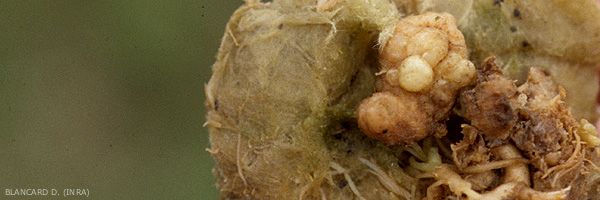
(Smith & Townsend 1907) Young, Kuykendall,
Martinez-Romero, Kerr & Sawada 2001
Bacterial tumors
- classification : Bacteria, Proteobacteria, Alphaproteobacteria, Rhizobiales, Rhizobiaceae
- synonymies : Agrobacterium tumefasciens (Smith and Townsend 1907) Conn 1942
Agrobacterium radiobacter (Beijerinck & van Delden 1902) Conn 1942
- English name: crown gall
Rhizobium radiobacter (Agrobacterium tumefasciens ), a Gram - bacterium found in the rhizosphere of many plants, is widely distributed around the world . Very polyphagous on dicotyledons, it attacks plants belonging to more than 60 botanical families, which are woody or herbaceous. Despite this, it is poorly reported on tomato, causing tumors especially in soilless crops.
In France , we observed its damage very occasionally in soilless crops located in the South-East. The impact of his attacks on plant growth and yields was negligible.
The biology of this bacterium and its infectious process are quite original. The mechanism used to parasitize a plant involves the integration of part of its genome, a fragment plasmid Ti of the tumor-inducing (T-DNA), into that of the plant. This is why it is used in transgenosis as a vector making it possible to integrate desired genes into the genome of plants.
Several biovars of Rhizobium radiobacter were described. The biovars 1 of A. tumefaciens , of ' A. rhizogenes and ' A. radiobacter were grouped into a single taxon: A. tumefaciens . The crown gall of grape is caused by him biovar 3 d ' A. vitis ; it was spread all over the world by cuttings.
Note that biovar 1 d ' A. radiobacter , and possibly other bacterial species, are involved in a root systems of disease of cucumber and tomato called by the Anglo-Saxons " root mat ." This disease, which is now rampant in several European countries, mainly affects soilless crops; it is emerging in Brittany.





